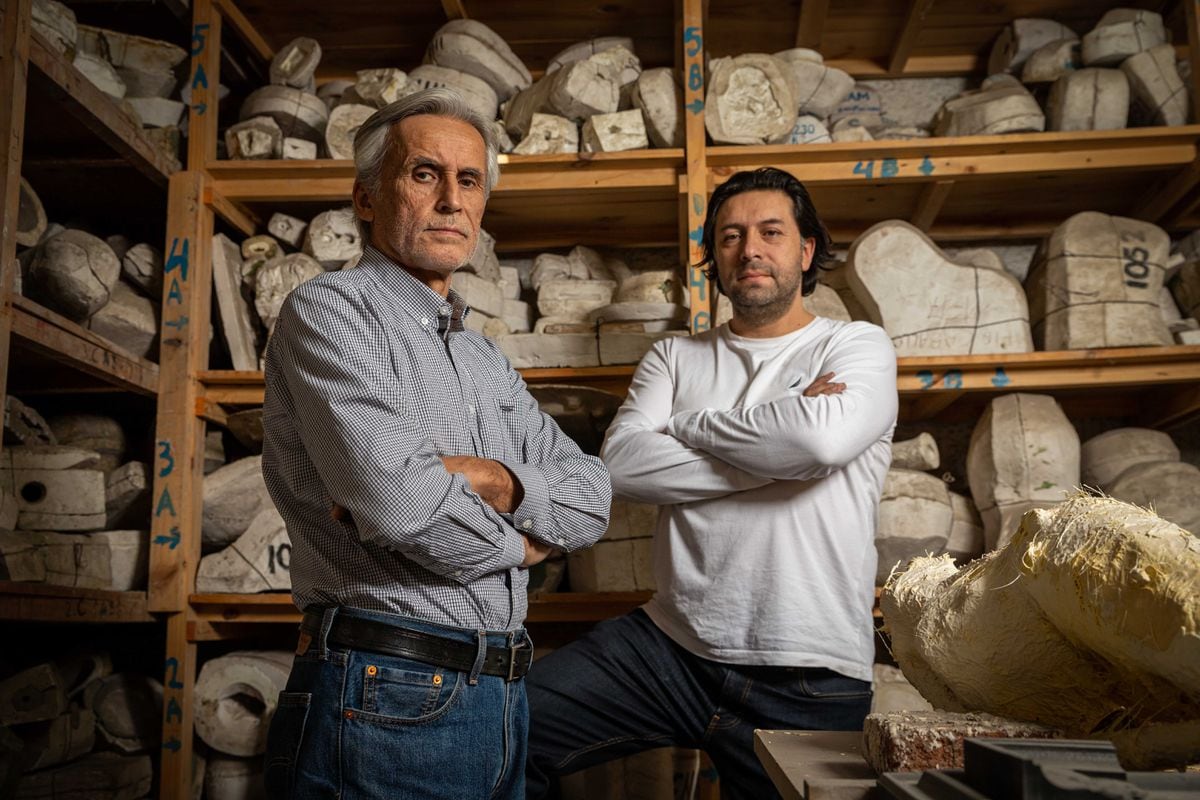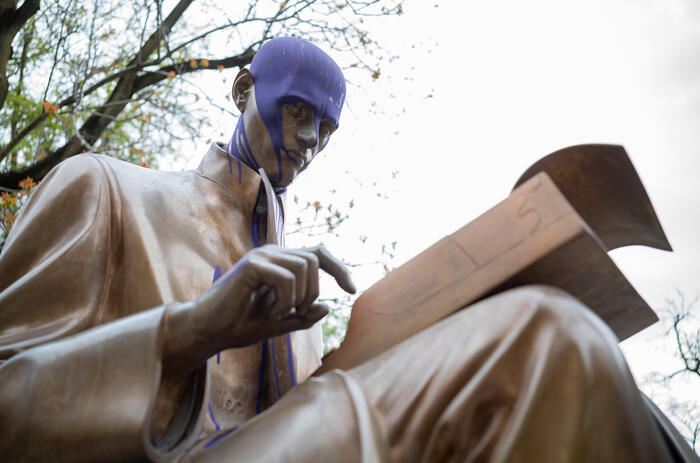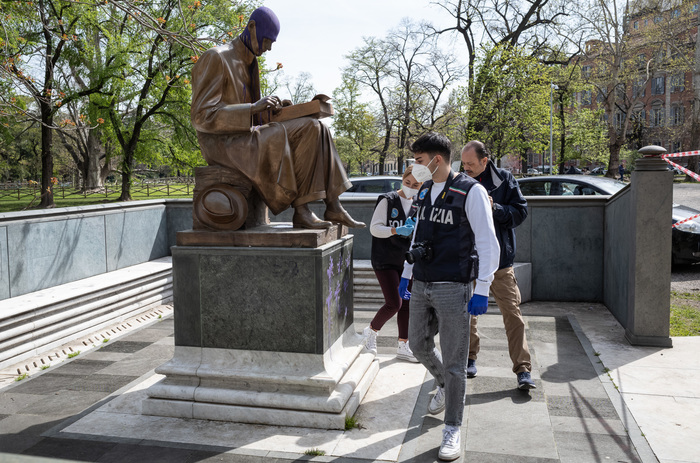The removal of the monument to General Manuel Baquedano on the morning of March 12, 2021 from Plaza Italia is one of the images that marked the social protests in Santiago de Chile.
The bronze sculpture by Chilean artist Virginio Arias (1855-1941), placed almost a century ago in the center of the capital, had become a symbol of dispute during the uprisings.
After serious damage to the structure, the National Monuments Council urgently commissioned the Montes Becker sculpture workshop to remove and repair the work.
This week, without its final destination being clear, the monument was reinstated in the Military Historical Museum.
The protagonists of the reconstruction, Luis Montes Becker and his son Luis Andrés Montes Rojas, reveal the details of the operation and the work involved in recovering the work hidden under a crust of paint.
"When people see the restored monument they say: oh, they just cleaned it," sculptor Luis Montes Becker said Wednesday in his workshop in La Pintana, south of the capital.
The assessment is far from reality.
To the fine restoration work led by the Montes duo for six months, we must add the complexity of removing the work against the clock from its site in a hectic social and political climate.
During the social outbreak, the sculptures of streets, avenues and squares were blackboards for demands, covered under spray paint.
But some were torn from their pedestals or smashed to pieces.
The monument to General Manuel Baquedano, considered a hero of the War of the Pacific that pitted Chile against Bolivia and Peru between 1879 and 1884, suffered especially due to its location in the heart of the riots.
In January 2020, three months after the protests began, the National Monuments Council (CMN) asked the Montes for an evaluation of the figure.
The sculptors recommended restoring some seriously affected pieces, but leaving the work in place.
“The sculptures in Chile do not sit on pedestals and therefore are not simply removed with a crane.
They are designed to withstand up to a 10 degree earthquake.
Most likely, a building will fall before a sculpture”, explains Montes Rojas, doctor in Sculpture.
In addition to the solidity of the anchoring systems, they valued the existing dialogue between public heritage and the city.
Detail of the damage suffered by the sculpture of General Baquedano during the 2019 riots in Santiago.
Archive Montes Becker Workshop
The scene was turned upside down when a group of men dressed in white overalls tried to knock down the sculpture with cutting tools during the International Women's Day demonstration on Monday, March 8, 2021. In 20 minutes they managed to destabilize 50% of the legs of the horse on which Baquedano is posing, until the demonstrators themselves prevented them from continuing.
The fall of the work of 4,000 kilos on the crowd could have had catastrophic consequences.
Early the next day, the Montes went to evaluate the structure again and presented the seriousness of the matter to the CMN, which ordered them to urgently remove the work with the help of other entities.
The task was a major challenge because there were no documents detailing how the iconic piece was attached.
Reports commissioned by the CMN from structural engineers revealed that the sculpture - the rider on the horse and the base (base) - was anchored to the pedestal by two steel bars bolted to the center.
It was clear to the sculptors that the pedestal had been filled with cement through these tubes, but they did not know if the concrete had trapped the plinth internally, which would prevent the complete work from being removed.
Montes Becker, with more than 30 years of experience, remembers the weight she felt at the beginning of the operation.
“We were working at 12 at night, with the public against us, with television, the spotlights, it was almost like a reality show.
Very stressed.
With soldiers, carabineros, three security circles… One is not used to working with that tension, much less with the symbolism and political charge that the monument had.
If one missed, the race was over”, he maintains.
They verified that the plinth was filled with cement, so they could not extract the entire work without the risk of a crack.
Nor could they demolish the pedestal as it is of a patrimonial nature.
Forced to apply plan B, they separated the base from the horse: they made two rectangular cuts on the surface of the base, each with two legs of the animal.
"The goal was to remove the work, but I was personally interested in rescuing the sculptor's work," says Montes Becker.
Father and son are academics at the School of Fine Arts of the University of Chile, of which Virginio Arias was director.
“In some way we are heirs to his sculptural and academic tradition.
Baquedano is a work by one of the three masters of Chilean sculpture in the 19th century.
We owe him a debt”, adds Montes Rojas.
The sculpture of General Baquedano during its restoration. Montes Becker Workshop Archive
The sculpture after the restoration works. Montes Becker Workshop Archive
After two hours of work, a crane managed to cleanly extract the horse with its rider and take it to the hangars of the former Cerrillos airport, today belonging to the Ministry of Culture.
That space was converted into a repair shop.
"The damage to the sculpture was not only due to the interventions of the public, but also due to the enormous layers of paint that were applied to erase the interventions," explains Montes Rojas.
They tried several cleaning methods, but only the glass microsphere allowed them to discover what was hidden by the hundreds of colors with which it had been intervened.
A deep cut appeared on the rider's neck.
But also the national coat of arms on the saddle, on the belt, the ornaments on the jacket, among other delicate details made by hand.
“When you do the cleaning you say: oh, we're seeing something we've never seen before,” says Montes Becker.
They didn't clean the whole room.
With the purpose of leaving a historical testimony of what was experienced during the explosion, four small and almost imperceptible areas were left intact.
One between the horse's ears and one at the front of the saddle.
When they cleaned the base, which was removed a year ago, a signature from 1928 was revealed: Virginio Arias.
The sculptors also restructured the horse's tail, the rider's legs and replaced the missing pieces based on photographic records.
They molded and fused the spur, the brooch, the dragon, among others.
They dyed it with chemicals until they found the color they thought was right and created a new anchoring system.
With emotion they remember when, finally, they put Baquedano back on his base.
The restoration of the figure cost about 68 million pesos (about 78,000 dollars), financed by the Presidential Delegation.
What is being done now with Baquedano's sculpture is one of the questions that still has no answer.
Initially, the Government of Sebastián Piñera intended to relocate it to Plaza Italia before his term ended in March, but the idea did not prosper.
“I am already satisfied that it is restored.
Right now it is in a place where it is not going to be harmed," says Montes Becker, who in any case suggests that it could be in a public place, such as the esplanade of the Commander-in-Chief of the Army, in front of the faculty of engineer from the University of Chile.
Montes Rojas advocates discussing the issue with specialists, politicians and citizens.
"A discussion about such an important symbol deserves that we make every effort to find a consensual solution."
“You have to take the drama out of the city changing.
We have changed it a thousand times,” he maintains.
“And we have also deleted half of the story a thousand times,” adds his father.
Luis Montes, father and son, at the Montes Becker workshop facilities. Cristian Soto Quiroz
Subscribe here
to the EL PAÍS América newsletter and receive all the key information on current affairs in the region.







/cloudfront-eu-central-1.images.arcpublishing.com/prisa/VPFGNZM6LJAQDDMVAJ5KXNW7UM.jpg)



/cloudfront-eu-central-1.images.arcpublishing.com/prisa/KMEYMJKESBAZBE4MRBAM4TGHIQ.jpg)



